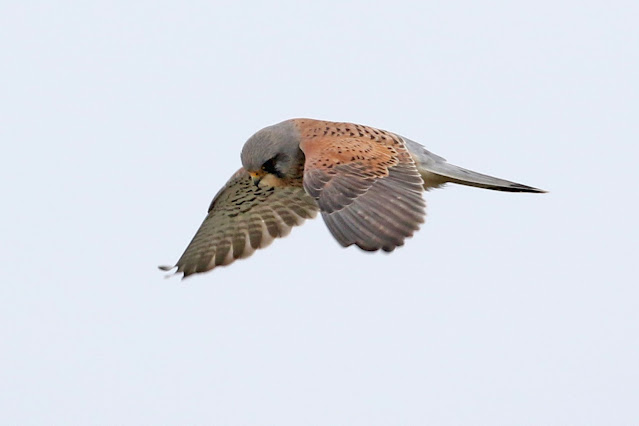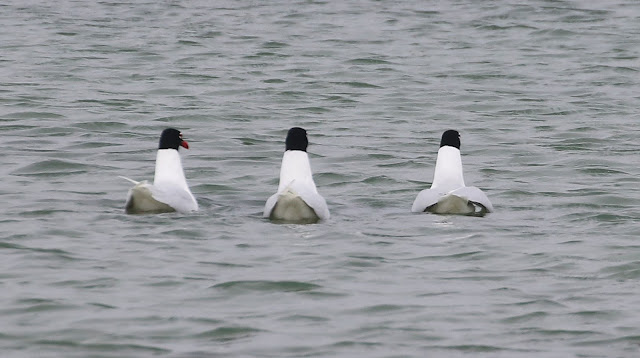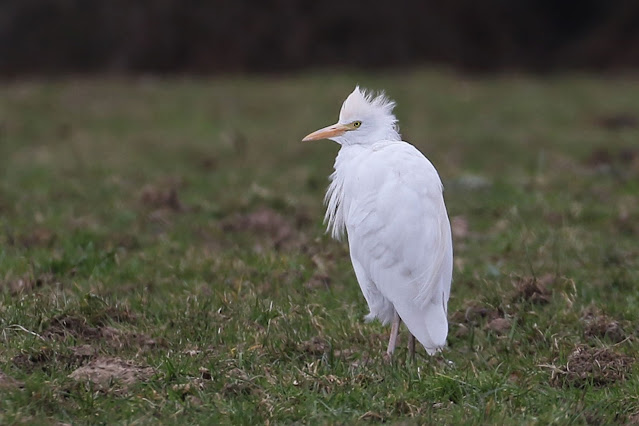I must admit to being a little surprised when Ian suggested Farlington to meet up. It was a cold still overcast day, the clouds that leaden grey, typical of the March doldrums, that period between the winter and the onslaught of spring migration. We met just after sunrise, but there was no sun, and set off around the sea wall, taking the west side, heading towards the Lake. As the marsh opens up you can scan along the stream that runs from the Lake and two white forms by the side of the water could only be sleeping Spoonbill, hopefully we would catch up with them later.
The tide was on the way up and water was filling the many channels in the mud, this pushed the Pintail close to the sea wall.
They won't be with us for much longer so I wanted to the opportunity now to get some more images of my favourite duck.
At the sluice from the Lake stood a lone Curlew.
We scanned the marshes as we walked in the hope of an early morning Short-eared Owl, but with no luck, the marshes covered in Wigeon and Brent Geese.
Several Meadow Pipit were along the sea wall, this individual posing nicely.
We walked around Point Field and then up the east side with nothing of significant interest to report. Groups of Brent were all over the marsh and fields butthere was no sign of the recent Black Brant.
As we reached the Information hut a female Marsh Harrier could be seen quartering the reed bed.
Where the stream runs alongside the path there were several roosting Teal, there reflections in the still waters.
Clearly visible here, the green speculum.
We walked around the stream, heading for the area where we had seen the Spoonbill from the sea wall earlier and we found them still with heads tucked under the wings, surrounded by gulls.
From the crests we assumed these were adult birds.
There was a pair of swans that were set on evicting another and were quite aggressive and as they came close to the Spoonbill they became much more alert and we could see the bills, the colour of which confirmed that they were adults.
Awake it was time for more preening and showing off the crest, which from this angle reminded us of Beaker from the Muppets.
In this position the head feathers were dipped into the water!
But it wasn't long until a return to rest.
I mentioned they were surrounded by gulls, there were in fact six species of gull on the Stream close by, Black-headed, Mediterranean, Lesser and Great Black-backed, Herring and this very smart Common Gull.
Back to the Spoonbills and alert once more.
And a mixture of preening and sleeping.
But eventually it was back to roost.
We made our way back to the sea wall where the tide was now quite high, we decided to head back to the cars and pay a visit to the Hayling Oyster Beds.
Fortunately it was still early and with the cold and grey weather the car park wasn't busy. We set off along the main track to the small lagoon on the land side of the Billy path. A selection of waders were feeding here, a couple of Redshank, Black-tailed Godwits and this Greenshank.
It was though the Black-tailed Godwits that provided the interest. A combination of the reflection in the water and the ripples made by the birds feeding provided some really nice combinations.
We walked around the Oyster Beds, with e calls of Mediterranean Gulls above us. Out at sea there were Goldeneye and Red-breasted Mergansers, but no sign of the hoped for Long-tailed Duck. I did manage to find three Black-necked Grebes and this prompted a walk to the far side of the Oyster Beds.
On the lagoon the Mediterranean Gulls numbers were beginning to build up, adults on the rocky bunds and in the air sporting their smart full black hoods and bright red bills and legs.
Scanning the harbour we found the Black-necked Grebes again, but unfortunately they were too far out for any chance of of a picture. Closer in were a pair of Red-breasted Mergansers and a Rock Pipit on the rocks below us.
A male Kestrel was hunting over the rough grass around the rocks.
While off shore there were plenty of Grey Plover moving around.
With still no sign of the Long-tailed duck we decided to turn attention to the Mediterranean Gulls. At this time of years the gulls arrive and numbers gradually build to quite a few hundred. The gulls are engrossed in display and breeding before they disperse to areas with in the harbour or further a field. It is a special event with the raucous calls of the Black-headed Gulls softened by the mew calls of the Mediterranean Gulls.
Gulls were in the air, on the water and settled on the bunds where they would continue their calls and displaying.
They would rise and make a wide circuit out over the lagoon and
then come back to the bund, sweeping into the northerly breeze and with much
hesitant fluttering and obvious dislike from those already on the
ground, land in the throng once more before others would rise to
perform the same routine.
Here an appreciation of the black hood and red bill contrasting with the all white plumage.
A black-headed Gull, rather drab in comparison.
While they look very smart in flight, they would have looked better against a deep blue sky. We will leave that for another time.
We made our way back to the car park, stopping along the way to continue the fruitless search for the Long-tailed Duck. I think we can consider that bird gone now.
A debate then followed, where to next, we wanted to return to Farlington for the afternoon so in the end elected to drive around to Warblington to see if we could find the Cattle Egret.
Normally we arrive park and then have to walk around the lanes in search of cattle and the egrets, ending up with a distant brief view. However as we drove along Church Lane towards the junction with Pook Lane there were cattle in the field and with them six Cattle Egret and a single Little Egret. We parked and found the best place to get some classic Cattle Egret photographs.
A
small, white heron. Cattle egrets are only slightly smaller than a little
egret, but with a shorter neck, shorter legs and much more compact body giving
them a stockier impression. They also have a shorter, stubbier bill, which is
dark in juveniles but quickly turns yellow.
Young Cattle Egrets and adults in winter are all white but
in the breeding season the adults show bright orange-yellow feathers on the
crown, lower back and chest. These brighter feathers can be visible from spring
well into autumn. The yellow bill also turns a brighter red-orange during the
breeding season, and the dark or greyish-yellow legs take on brighter yellow
and then pinkish tones.
As the name suggests, cattle egrets can often be seen close
to cows, as well as other large grazing mammals. They follow the larger animals
around, feeding on the insects and other invertebrates that they disturb.
Studies of the diet of cattle egret in other parts of the world have revealed
that crickets and grasshoppers are one of their favourite foods, though they
will feed on a wide variety of prey, from ticks to frogs. Cattle egrets are
sociable birds and prefer to nest in colonies, often mixed in with other
herons.

Cattle Egrets have shown one of the greatest range
expansions in the world of birds. At the beginning of the 20th century, the
western form of Cattle Egret was only established in southern Spain, Portugal
and North and tropical Africa.
Over the next few decades they spread south to
South Africa and began to spread north across Europe. They even managed to
cross the Atlantic to reach South America, and have dispersed throughout that
continent and up into North America, with breeding recorded as far north as
Canada.

Only a few decades ago, cattle egrets were still rare
visitors to the UK, until a large influx over the winter of 2007/2008 saw over
200 birds recorded here, mostly in south-west England. This led to the UK's
first record of breeding cattle egrets, with at least two pairs nesting in
Somerset in the summer of 2008. Since then, they have become an increasingly
common sight in the UK and, although still a rare breeding bird here, have
nested in several other counties including Hampshire and look likely to become
more established.
The Cattle Egret is a cosmopolitan species
of heron found in the tropics, subtropics, and warm-temperate zones. It is
the only member of the genus Bubulcus, although some
authorities regard its two subspecies as full species, the Western Cattle Egret and
the Eastern Cattle Egret. Despite
the similarities in plumage to the egrets of the genus Egretta,
such as Little Egret, it is more closely related to the herons of Ardea,
the Grey and Purple Heron being examples.
This was probably the best views I have had of the Cattle Egret here at Warblington.
The calls of a Buzzard close by suddenly spooked the flock and they took to the air, initially circling around the field, but then they started to break up and goo off in different directions but mostly away to the fields away to the east and down to the harbour.
We had about fifteen minutes with the egrets and we could only thank our luck because if we had arrived a little later there was a good chance we would not have seen them at all.
We took the opportunity to have some lunch before setting off for the second part of the day, more of which later.































































No comments:
Post a Comment